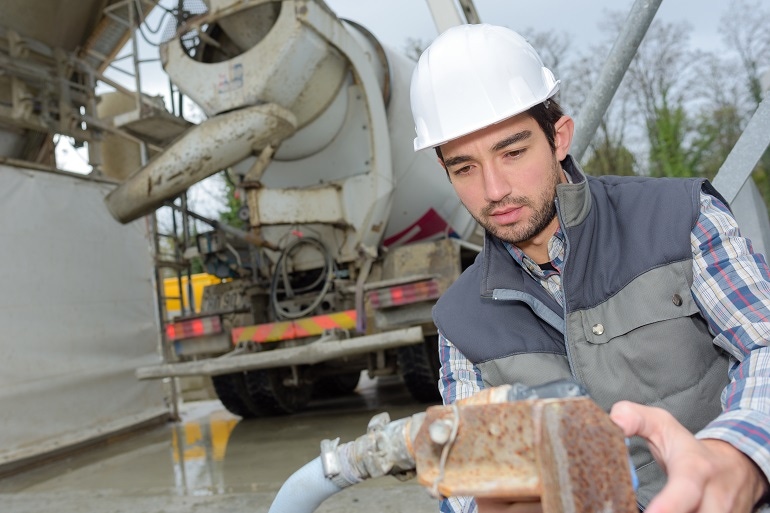When Quieter Speaks Louder
Audible back-up alarms have reduced struck-by accidents on construction sites. Today, innovators have developed a back-up device that emits a white-noise, whooshing sound that is easier to locate and doesn't disturb the neighbors.

Struck-by accidents continue to be a leading cause of property damage and serious employee injuries on jobsites around North America. The struck-by accident classification includes unsafe actions ranging from swinging boom buckets to the falling of unsecured loads. But there continues to be one action that always leads in this category and that has thus received the greatest attention of safety professionals – vehicle-backing accidents.
The consequences to construction workers from struck-by backing accidents were thoroughly outlined in a 2017 report published by CPWR—The Center for Construction Research and Training. Reviewing OSHA accident statistics from 2011 to 2015, the researchers determined that nearly one in five (18%) of construction workers who died did so as a result of being struck by an object/equipment or a vehicle. Contractors who specialized in the highway, street, and bridge construction sector reported the highest number of struck-by fatalities. The majority of these fatalities were due to being struck by a vehicle on the job.
The CPWR report offered solutions contractors can take to help prevent struck-by accidents, including controlling traffic and pedestrian patterns on jobsites; posting signage alerting drivers, operators, and field personnel of potential blind spots; incorporating cameras and radar systems on equipment; and equipping vehicles with back-up alarms.
Audible back-up warning systems
The contribution of audible back-up alarms to the reduction of struck-by accidents on construction sites was first recognized in Europe in the 1970s. In 1979 the Occupational Safety and Health Administration (OSHA) embraced this safety tool. They identified back-up alarms mounted on large construction vehicles as a key safety control option. The standard recommends this option for motorized equipment with an obstructed view that operates within an off-highway jobsite, not open to public traffic.
In subsequent OSHA statements, the importance of back-up audible alarm systems has been reinforced. For example, bidirectional machines, such as rollers, compactors, front-end loaders, bulldozers, and similar equipment, with obstructed views must be equipped with a horn, distinguishable from the surrounding noise level, that operates when the machine is moving in either direction.
New Noise Levels
Early back-up alarms were developed by the U.S. military. When these devices were introduced to the construction industry, manufacturers began to offer a wide range of loud “beep-beep” sequences. The sound patterns complied with OHSA regulations when nearby workers could discern the warning from the ambient noise level. But as these warnings became commonplace, that the effectiveness was reduced.
In a 2010 report titled Technology for a Quieter America, the National Academy of Engineering cited loud back-up beepers as one of the six top noise sources people associated with behavioral and emotional consequences. At the same time industrial safety researchers surveyed 20 state departments of transportation about job-site noise concerns. The state officials identified single-tone back-up alarms as a major problem in generating nighttime construction noise. In some regional studies of job site accidents, safety professionals found evidence that the overall safety credentials of the traditional “beep beep” system were unreliable. They reported that nearby workers found the warning signals confusing, and often ignored the noise.
White Noise Solutions
In the 1990s, innovators developed a back-up device that emitted a sound cadence similar to a conventional alarm, but that was broadcast as a white-noise, whooshing sound. Nearby workers or pedestrians can easily hear the quieter warning sound when in the backing vehicle’s path. One key benefit of the white noise warning is that sound waves are more easily localized than a single-tone beeper. The white noise broadband sound also gives workers wearing hearing protection and people with hearing difficulties a better chance of hearing its warning signal.
Corey Heniser, a vehicle safety expert at Brigade Electronics, explains how the technology works. The units create an alternative alarm using broadband technology. Their version of the white noise alarm is called bbs-tek White Sound. The device emits a “ssh-ssh” sound, similar to that of breaking waves on a beach. The pattern is highly directional and easy for pedestrians to pinpoint. To watch a video of how this works, click here.
Embracing White Noise Safety
Recently Trans Route Béton, a trucking company based in Limoges, France that delivers ready-mixed concrete for Lafarge, upgraded their fleet of rear discharge mixers. With road incidents being a significant concern, the company took progressive action to ensure its rear-discharge concrete mixers were fitted with cutting edge vehicle safety technology to prevent road and job site incidents. The upgrade included the bbs-tek White-Noise technology and a specialized camera monitoring system that eliminates blind spots by providing a complete surround view of all four sides of a vehicle.
Othmane Jennane with Trans Routes Béton, has been pleased by the results of the new technology. “With just one look, drivers have a complete surround view of the vehicle without any blind spots and the added peace of mind that pedestrians will be warned by the white noise alarm.”
Reducing noise pollution
An additional benefit of the white noise warning device is its effect on the environment. White noise is masked by community noise, so it is much less annoying to the public than beeping back-up alarms, reducing noise pollution.
White-noise warning devices are effective tools when contractors are conforming to local noise ordinances. While many jurisdictions exempt construction activity from some noise regulations, the white noise alarms can reduce exposure in normal delivery areas. Recently New York City public health officials recommended the installation of white noise back-up alarms on all construction vehicles.
“The benefits of white sound for road and workplace vehicle safety are manifold and proven to save lives,” said Brigade’s Heniser.
The full range of back-up alarm products from Brigade includes a 360-degree camera system, camera monitoring systems, white noise back-up alarms, obstacle detection sensors, obstacle detection radar, and digital recorders. To learn more about these systems, click here.
About the Author(s)
You May Also Like




